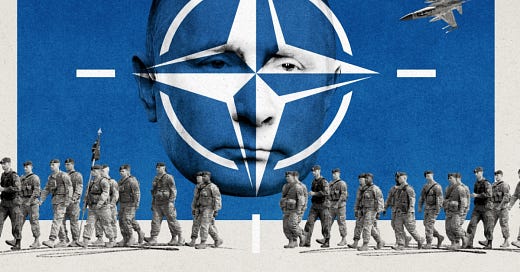NATO Calls for Military Spending Hike Amid Russian Threat
6/11 - International News & Geopolitical Analysis
NATO Secretary-General Mark Rutte issued a stark warning to alliance members this week, emphasizing that Russia may be preparing for military confrontation with NATO within the next five years. In a pointed speech delivered in London, Rutte underscored the pressing need for a dramatic surge in defense spending and weapon production across the alliance. He argued that even if the war in Ukraine were to end soon, the broader geopolitical threat posed by Russia would remain.
Rutte, recently appointed NATO chief and formerly the prime minister of the Netherlands, is leading the alliance at a moment of deep strategic uncertainty. His remarks come ahead of a critical NATO summit in The Hague, where U.S. President Donald Trump is expected to reassert his controversial vision of transatlantic defense cooperation. Trump, a vocal critic of European defense spending, is likely to push for a bold new funding goal: a 5% of GDP benchmark for defense, with 3.5% earmarked for direct military expenditures and the remaining 1.5% for ancillary defense-related investments.
The proposed target marks a substantial increase from the current 2% standard—a goal only recently met by countries like Italy and Spain, more than a decade after its introduction. Some NATO states, particularly those on the alliance's southern flank, have been slow to ramp up their military capabilities, often arguing that Russia poses no direct threat to their national security. Convincing countries like Spain to endorse the new objective has proven difficult, though they are now expected to support the initiative without vetoing it.
Rutte’s warning was backed by new internal assessments approved by NATO defense ministers, which outline capability targets necessary to implement regional defense plans. Though the details are classified, priorities reportedly include bolstering air and missile defenses, expanding land force formations, and enhancing logistics and long-range strike capabilities.
Rutte painted a sobering picture of NATO’s readiness by emphasizing the fact that Russia manages to produce in three months the volume of ammunition NATO produces in a year. Throughout their 3 year war in Ukraine, Russia has transformed itself into a well-oiled war economy, whereas the Transatlantic alliance’s current supply chains are ill-equipped for sustained conflict. To bridge the gap, NATO aims to acquire thousands of additional tanks and armored vehicles, millions more artillery shells, and double support infrastructure such as logistics, transportation, and medical services. Plans are underway to procure hundreds of warships, drones, long-range missiles, and over 700 U.S.-made F-35 fighter jets.
This ambitious rearmament push is being met with cautious optimism. While front-line states like Poland and the Baltic nations have already committed over 4% of GDP to defense, other members—particularly in Western Europe and North America—face criticism for lagging behind. Notably, the U.S., once a pillar of NATO military spending, now allocates a smaller share of its GDP to defense than it did in 2014, raising some eyebrows even as it pushes allies to spend more.
Trump’s proposed 5% benchmark is designed to address this imbalance. However, his administration’s own defense budgeting has shown signs of inconsistency. While a $150 billion injection into the Pentagon is included in the current spending bill, projections for fiscal year 2026 suggest a potential decline in defense outlays when adjusted for inflation.
The broader strategic calculus underpinning these developments is rooted in fears of a future Russian assault on NATO soil. Intelligence assessments have increasingly concluded that Moscow could shift its war machine toward a new front in Europe once the war in Ukraine winds down. The Kremlin’s production of artillery, missile systems, and armored vehicles has skyrocketed, fueling speculation that Russia may be positioning itself for a confrontation with NATO.
Rutte’s warning that the entire alliance now resides on the “eastern flank” reflects a shift in thinking among European leaders, who had long considered Russian aggression a localized issue. The war in Ukraine has fundamentally altered those assumptions, and NATO is responding with a new urgency.
Yet for all the planning and investment, questions persist about the alliance’s cohesion. Trump’s return to the diplomatic arena brings both opportunity and risk. While his administration has signaled a desire to see NATO take more responsibility for its own defense, critics argue that this may be code for a gradual American retreat. European officials are working to ensure that any pivot by the U.S. toward Asia, particularly in light of rising tensions with China, does not leave Europe exposed.
Analysis:
The NATO alliance is undergoing a transformation as it confronts the realities of modern warfare and great-power rivalry. Rutte’s address marked a pivotal moment in the strategic reawakening of Europe, urging allies to accept that security can no longer be taken for granted.
The 5% defense target, long considered politically untenable, now appears to be within reach—driven by the combination of Russian aggression and Trump’s pressure tactics. However, this shift comes with risks. A surge in defense spending without a corresponding long-term strategy could result in wasteful procurement and public backlash. Moreover, if NATO members see increased investment as a replacement for U.S. commitment rather than a supplement, the alliance’s unity could fray.
There’s also the question of sustainability. While high levels of defense spending may be justified amid current threats, maintaining those levels over decades will challenge governments already grappling with post-pandemic debt, social demands, and declining welfare provisions.
Still, the urgency cannot be ignored. As Rutte noted, Russia’s wartime economy—though dwarfed in size by NATO—has proven capable of outproducing the alliance in key military areas. Bridging that gap is now seen as not only a matter of preparedness, but of deterrence.



